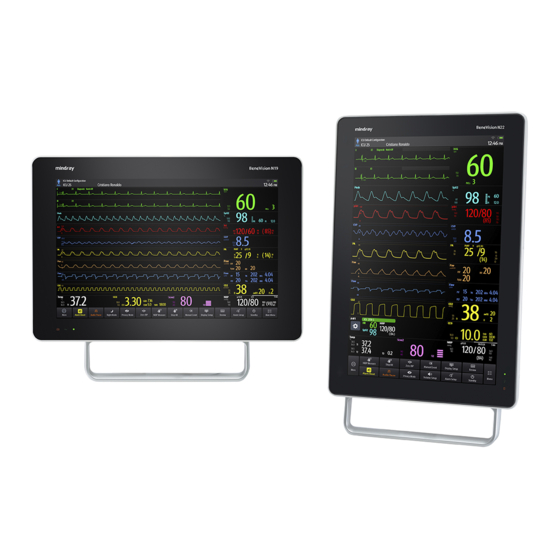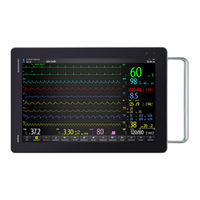
Mindray BeneVision N22 Acuity Monitor Manuals
Manuals and User Guides for Mindray BeneVision N22 Acuity Monitor. We have 4 Mindray BeneVision N22 Acuity Monitor manuals available for free PDF download: Operator's Manual, Service Manual, Quick Reference Manual
Mindray BeneVision N22 Operator's Manual (528 pages)
Patient Monitor
Brand: Mindray
|
Category: Medical Equipment
|
Size: 6 MB
Table of Contents
-
Safety33
-
Warnings33
-
Cautions34
-
Notes34
-
Intended Use37
-
Menus59
-
Quick Keys59
-
Privacy Mode62
-
Night Mode62
-
Standby Mode63
-
User Screens75
-
Remote View92
-
Alarm Watch94
-
Mldap95
-
Troubleshooting102
-
Alarms111
-
Alarm Categories111
-
Alarm Priorities112
-
Alarm Indicators112
-
Resetting Alarms120
-
Latching Alarms120
-
Nurse Call121
-
Calling for Help121
-
CPB Mode121
-
Intubation Mode122
-
Testing Alarms122
-
ECG Introduction123
-
ECG Display124
-
ECG Relearning148
-
Calibrating ECG149
-
Resp Display156
-
Spo Introduction161
-
Spo Display164
-
NIBP Display179
-
NIBP Maintenance183
-
IBP Introduction185
-
Measuring ICP187
-
IBP Display188
-
Measuring PAWP192
-
Measuring PAWP193
-
C.O. Display198
-
Troubleshooting202
-
Scvo Display203
-
Guide204
-
Measuring Scvo204
-
Scvo Calibration205
-
Setting Hb/Hct205
-
Value206
-
CCO Display208
Advertisement
Mindray BeneVision N22 Operator's Manual (472 pages)
Patient Monitor
Table of Contents
-
-
Safety
25 -
-
Intended Use30
-
-
-
-
-
Menus47
-
Quick Keys47
-
-
Privacy Mode49
-
Night Mode50
-
Standby Mode51
-
-
-
-
-
Remote View73
-
Alarm Watch75
-
-
-
-
-
Alarms95
-
Data Storage95
-
-
9 Alarms
97-
Resetting Alarms109
-
Latching Alarms110
-
Nurse Call110
-
CPB Mode111
-
Intubation Mode111
-
-
Testing Alarms114
-
-
ECG Introduction116
-
ECG Display117
-
ST Monitoring131
-
ECG Relearning139
-
-
-
-
Resp Display148
-
-
Spo Introduction154
-
Spo Display156
-
-
-
-
NIBP Display170
-
NIBP Maintenance174
-
-
IBP Introduction176
-
IBP Display178
-
Measuring PAWP182
-
-
-
C.O. Display189
-
Troubleshooting193
-
-
Scvo Display196
-
Measuring Scvo2197
-
Scvo Calibration198
-
Mindray BeneVision N22 Service Manual (105 pages)
Patient Monitor
Table of Contents
-
1 Safety
13 -
-
Overview15
-
Power System22
-
-
-
-
Introduction51
-
Advertisement
Mindray BeneVision N22 Quick Reference Manual (40 pages)
Brand: Mindray
|
Category: Medical Equipment
|
Size: 0 MB



